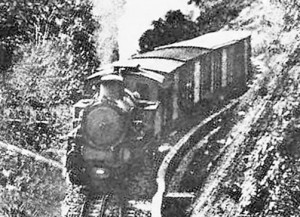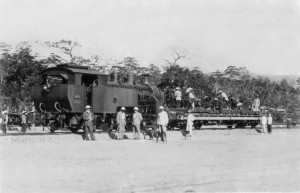
An SLM HG4/4 0-8-0T rack-and-pinion locomotive negotiates the Bellevue Pass in early 1927
For many people it comes as a surprise to learn that before 1975 Việt Nam had its own Swiss-built cog railway line, an 84km branch which connected Tháp Chàm in Ninh Thuận Province with the central highlands resort of Đà Lạt.

SLM HG4/4 0-8-0T rack-and-pinion locomotive No 707
The history of Đà Lạt may be traced back to the 1890s when it was founded by the French as a high-altitude health spa where colonial residents could escape from the heat of the Mekong Delta and coastal region.
Plans to connect the town by rail with the North-South line at Tourcham (Tháp Chàm) were drawn up before the end of the 19th century, but in the event the 84km branch line took almost 30 years to build.
Work on the first 40km from Tourcham to Krông Pha got under way in 1903, but although it involved only conventional adhesion rail technology, the project suffered numerous delays and the line was not inaugurated until 1919.

An SLM HG4/4 0-8-0T rack-and-pinion locomotive in the Bellevue Pass in the 1930s
The final 44km involved an ascent from 186m to 1,550m, with steep gradients of up to 120mm/m, so the Swiss cog railway company Schweizerische Lokomotiv- und Maschinenfabrik (SLM) of Winterthur, represented in Indochina by the Société d’entreprises asiatiques, was entrusted with the work. Construction began on 20 March 1923 and the line was completed in 1932.
At the outset, nine Schweizerische Lokomotiv- und Maschinenfabrik (SLM) superheated 46-tonne HG4/4 0-8-0T rack-and-pinion locomotives (originally numbered 701-709) were purchased to haul trains on this line. Seven of these (701-705, 708-709) were built at SLM’s Winterthur factory, while the remaining two (706-707) were built on their behalf by Maschinenfabrik Esslingen.
The new cog railway played a key role in the development of Indochina tourism, but the bulk of the line’s revenue was earned by transporting fresh fruit, vegetables and flowers from the market gardens of the Langbian plateau down to the lowlands.

SLM HG4/4 0-8-0T rack-and-pinion locomotive no 704 between Bellevue and Dran in early 1927
At the start of the first Indochina War in 1945-1946, the Langbian Cog Railway suffered extensive damage at the hands of the Việt Minh, who destroyed four of the line’s original HG4/4 locomotives, leaving just 40-302 (702), 40-303 (703), 40-304 (704), 40-306 (706) and 40-308 (708) in operational condition.
The line was repaired and reopened to public service in 1947. In that year, to replace the locomotives lost during the conflict, the CFI purchased an additional four second-hand 42-tonne SLM HG3/4 2-6-0T rack-and-pinion locomotives (numbered 31-201-31-204) from the recently-electrified Furka-Oberalp Railway in Switzerland.
For financial reasons, proposals in the 1960s by the South Vietnamese railway operator Hỏa Xa Việt Nam (HXVN) to electrify the line were abandoned, and in the years which followed, lack of investment, coupled with deteriorating security, began to impact seriously on the operation of the line.

The stylish art deco Đà Lạt Station building pictured in 1948
The Langbian Cog Railway continued to offer a public service until September 1969, when HXVN announced that “because the operation of the line is unprofitable, the line is short of locomotives and safety cannot be guaranteed, the HXVN will suspend operations until the security situation has improved.” In the event, the security situation did not improve and the line remained closed. After 1975 the track was removed.
Considerable controversy was generated in Việt Nam by the sale in 1990 of the surviving cog locomotives which lay rusting in the station yard at Đà Lạt. HG 4/4 locomotives Nos. 40-304 and 40-308, along with the four HG3/4 locomotives 31-201-31-204, were purchased by the Furka Cogwheel Steam Railway (Dampfbahn Furka-Bergstrecke, DFB) as part of the project to reopen the mountainous section of the old Furka-Oberalp Railway, and then repatriated to Switzerland. Since that time, 40-304 and 40-308 have been restored to service under their original numbers 704 and 708.

Rusting cog locomotives commencing their journey back to Switzerland in 1990….
However, the fate of the magnificent three-span iron railway bridge over the River Đa Nhim—broken up and sold for scrap in 2004 while the provincial authorities reportedly turned a blind eye —suggests that their return to Switzerland may have saved the old engines from an untimely end.
Since that time, the growth of tourism in Đà Lạt has fuelled a revival of interest in the abandoned cog railway. In 1992 the art deco Đà Lạt Station building was renovated as a national heritage site and a 7km adhesion rail section of the line from Đà Lạt to Trại Mát was reopened for tourists, using diesel traction. The Dalat Train Villa currently offers exploratory walks through abandoned tunnels and stations.
Since 1996, various plans have been advanced to rebuild the Langbian Cog Railway, but as yet it remains uncertain how and when this will be achieved.

…. now restored to their former glory on the Furka Cogwheel Steam Railway (image copyright Dampfbahn Furka-Bergstrecke)
Due to the specialist nature of cog railway technology, a complete reconstruction will be both complex and expensive, and success is likely to be contingent on the involvement of international technical expertise. At the time of writing a feasibility study has yet to be undertaken.
Had the original Tháp Chàm–Đà Lạt line survived intact, there can be little doubt that it would now be one of Asia’s most important tourist attractions and most probably also a UNESCO World Heritage Site like India’s famous Nilgiri Mountain Railway. If the plan to restore it is successful, Việt Nam could one day becoming one of Asia’s prime railway heritage tourism destinations. Understandably, the progress of the scheme to rebuild it has since been watched with great interest by the Vietnamese tourist sector.
Tim Doling is the author of The Railways and Tramways of Việt Nam (White Lotus Press, Bangkok, 2012) and also gives talks on Việt Nam railway history to visiting groups.
A full index of all Tim’s blog articles since November 2013 is now available here.
Join the Facebook group Rail Thing – Railways and Tramways of Việt Nam for more information about Việt Nam’s railway and tramway history and all the latest news from Vietnam Railways.
You may also be interested in these articles on the railways and tramways of Việt Nam, Cambodia and Laos:
A Relic of the Steam Railway Age in Da Nang
By Tram to Hoi An
Date with the Wrecking Ball – Vietnam Railways Building
Derailing Saigon’s 1966 Monorail Dream
Dong Nai Forestry Tramway
Full Steam Ahead on Cambodia’s Toll Royal Railway
Goodbye to Steam at Thai Nguyen Steel Works
Ha Noi Tramway Network
How Vietnam’s Railways Looked in 1927
Indochina Railways in 1928
“It Seems that One Network is being Stripped to Re-equip Another” – The Controversial CFI Locomotive Exchange of 1935-1936
Phu Ninh Giang-Cam Giang Tramway
Saigon Tramway Network
Saigon’s Rubber Line
The Changing Faces of Sai Gon Railway Station, 1885-1983
The Long Bien Bridge – “A Misshapen but Essential Component of Ha Noi’s Heritage”
The Lost Railway Works of Truong Thi
The Mysterious Khon Island Portage Railway
The Railway which Became an Aerial Tramway
The Saigon-My Tho Railway Line

